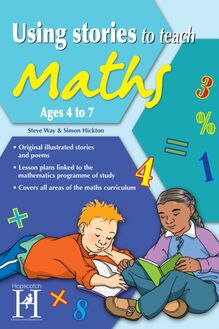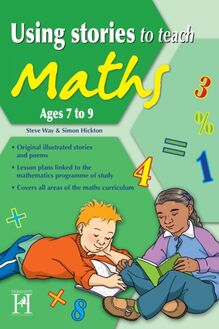Using Stories to Teach Maths Ages 4 to 7 , livre ebook
127
pages
English
Ebooks
2012
Vous pourrez modifier la taille du texte de cet ouvrage
Obtenez un accès à la bibliothèque pour le consulter en ligne En savoir plus
Découvre YouScribe et accède à tout notre catalogue !
Découvre YouScribe et accède à tout notre catalogue !
127
pages
English
Ebooks
2012
Vous pourrez modifier la taille du texte de cet ouvrage
Obtenez un accès à la bibliothèque pour le consulter en ligne En savoir plus
Title page
Using stories to teach Maths
Ages 4-7
Steve Way & Simon Hickton
Copyright page
Published by
Hopscotch,
a division of MA Education,
St Jude’s Church, Dulwich Road,
London, SE24 0PB
www.hopscotchbooks.com
020 7738 5454
©2011 MA Education Ltd.
Written by Steve Way & Simon Hickton
Illustrated by Emma Turner,
Fonthill Creative, 01722 717057
Illustrations on pages 85 & 86 by Brian Way
2012 digital version by Andrews UK Limited
www.andrewsuk.com
All rights reserved. This resource is sold subject to the condition that it shall not, by way of trade or otherwise, be lent, hired out or otherwise circulated without the publisher’s prior consent in any form of binding or cover other than that in which it is published and without a similar condition, including this condition, being imposed upon the subsequent purchaser. No part of this publication may be reproduced, stored in a retrieval system, or transmitted, in any form or by any means, electronic, mechanical, photocopying, recording or otherwise, without the prior permission of the publisher, except where photocopying for educational purposes within the school or other educational establishment that has purchased this book is expressly permitted in the text.
Every effort has been made to trace the owners of copyright of material in this book and the publisher apologises for any inadvertent omissions. Any persons claiming copyright for any material should contact the publisher who will be happy to pay the permission fees agreed between them and who will amend the information in this book on any subsequent reprint.
Introduction
Hello! We hope you enjoy using this book and that the ideas in it help add to your toolbox of resources for teaching mathematics. The main idea behind “Using Stories to teach Maths Ages 4 to 7” was to provide a way of looking at maths that the children have to learn in school from a fresh angle. This means that their learning can be enhanced by looking at maths ideas in different ways. Using the stories can be a fun way of helping the children with their learning and their revision. It also helps children to understand maths by encountering it in different contexts, such as the imaginary situations in the stories and in real-life situations. Every different way in which a child (or an adult!) comes across a maths concept enhances a child’s ability to learn and understand the concept and to remember it. The age categories we have put each story in are of course only a guide as all children are different and they can be of interest and use to older or younger children in the same or different contexts.
About this book
By making maths fun the barriers to learning that they often create (“I can’t do maths”, “maths is boring” or similar phrases that they may have picked up from others) can be dissolved and the children gain more confidence and facility to understand and use mathematical concepts and this can lead to a far more positive approach and attitude to the rest of their mathematical learning. Certainly having used these stories and poems in many schools around the UK we are confident that the children will enjoy engaging with them and learning from them.
The stories and poems in the book have been written and road-tested over a number of years in schools across the UK. They were originally written using the Mathematics Programme of Study as a guide to provide ideas for pieces we could write. For this reason we hope that between them the stories and poems can provide a resource for initiating or supporting work for many of the learning objectives of the Mathematics Programme of Study. Therefore in the teacher’s notes accompanying each piece we quote areas of the Mathematics Programme of Study that are covered by working with them with the children. For several of the first pieces, which are aimed at Foundation/Early KS1 (age 4-6), we have also noted relevant aspects of Early Learning Goals for the Early Years Foundation Stage. In the teacher’s notes we also suggest follow up work, often incorporating worksheets or the illustrations that accompany the pieces, which you can use to create a whole lesson around each piece. Of course, suggested lesson plans are only a guide and so you can pick and choose the suggestions and ideas that will work best in your school, with your class etc.
Reading the stories
When you read the children the story we recommend that you read them the story twice. The first time as a story in its truest sense - a story they can listen to and enjoy as a piece of narrative, without it being broken up and dissected as it’s told. Hopefully the enjoyment they get from the story will enhance their enjoyment of the mathematics they are learning. However on the first reading of the story, they may have been so involved in the plot etc that they miss some of the maths ideas that are used in the story. So on the second reading you can get the children to focus on the maths ideas that weaved into the story by stopping at the points where a new concept enters into the narrative and discussing its role in the story, using an enlarged copy. This also means that the children will be able to enjoy seeing - and learning from! - the illustrations as well and many of the children will enjoy reading the story with you.
Using the Lesson plans
Within the planning we have added reference statements headed WALT, WILF and TIB as these or similar systems are often used to ensure lessons are focussed, objective led and in context for the learner. They help summarise purpose of the lesson, what is required of the children in order for them to successfully learn that lesson and why what they are learning is important.
WALT stands for “We Are Learning Today.”
WILF stands for “What I’m Looking For.”
TIB stand for “This Is Because.”
The worksheets sheets are designed to support the learning the children are making in mathematics. We recognise that completing them will often require literacy skills, which in some cases the children will not have at the required level. In order that the work remains focussed on maths we suggest that you, your classroom assistants etc scribe for such children so that their capability in mathematics is not held back by specific difficulties with literacy.
The lesson plans in this book are differentiated particularly where we have included sections labelled “Further Suggestions” that give ideas that within the time constraints of a lesson maybe more suitable for higher attainers to carry out (or get around to!) though all the ideas could be explored to some degree by most children. Also most of the ways in which we recommend follow up to the stories mean that the children are encouraged to carry out investigative work which will be differentiated by the outcome of the children’s degree and skill of work.
We hope you enjoy using this book and would welcome all positive suggestions/criticisms that might enhance future volumes!
Finally we’d like to mention that many of the stories are based around a character called the Wise Wizz of Woo. Although many legends, most of them untrue, are told regarding this remarkable character, there are a few that we have been able to establish for certain. Although indisputably wise, he was not a wizard. He was however a wizz at mathematics. He lived a long long time ago (even before teachers were invented in fact - hurray!) hence his need to actually invent number shapes we use today, as none existed before and to then create living numbers and teach them to count in the correct order before being used by people. He had (or has?!) a time machine. He loved (loves?) strawberry jam. (Hope this helps.)
Contents
How the numbers got their shapes
A poem about how the Wise Wizz of Woo decided what shape they would be.
Maths theme: Exploring numbers 0-10
The Numbers learn their order
A story about the numbers from 1-10 learning to go in the right order when the Wise Wizz of Woo teaches it to them and being awful at it!
Maths theme: Exploring numbers 1-10
One to Twenty poem
A way of practicing and learning all the numbers from 1 to 20.
Maths theme: Exploring numbers 1-20
How Sir Cylinder saved Prince Pyramid from the Cruel Cuboid Creature for Princess Prism
A poem using lots of the mathematical vocabulary the children are expected to have come across and know (including the names of shapes!)
Maths theme: Mathematical vocabulary (comparisons)
The numbers have a quarrel
After they’ve finally learned to go in the correct order with the help of the Wise Wizz of Woo, (see “The Wise Wizz of Woo names the numbers”) this is a story about ordering numbers from one to ten in different ways.
Maths theme: Exploring features and patterns of numbers using numbers 1-10 including odd and even
Ten’s problem
Practising and learning order of numbers 10-20. Which number can 10 go to 20’s party with when 0 will be going with 20? Can the Wise Wizz of Woo help 10 out?
Maths theme: Exploring features and patterns of numbers using numbers 10-20 including place value
Joins and splits
Various bands are splitting up and re-forming (how unlike real life!) and different mountaineering teams join up to help each other get to the top of Mount Everest. How many people are in these new combinations?
Maths theme: “Real Life” addition and subtraction
Bernice the Octopus buys a watch
Being an executive Bernice needs a watch but as Carl the Crab asks, which tentacle is she going to wear it on? It’s a right ordinal conundrum!
Maths theme: Use of ordinal numbers, times of day
All shapes and sizes
A story about solid shapes including


